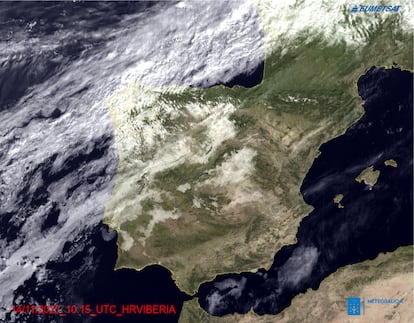Google’s artificial intelligence predicts the weather around the globe in just one minute
The program outperforms the main forecasting system in over 90% of weather variables

For years, artificial intelligence has been dethroning its creators—humans—in different areas. Now, it’s meteorology’s turn. The science is one of the greatest human creations since the Roman augurs; previously, they opened an animal’s guts to determine if the weather favored sowing the field or if the next morning’s conditions would be conducive to waging war. Today’s weather predictions are done with very complex models based on the laws governing the dynamics of the atmosphere and the oceans, which are run on some of the world’s most powerful supercomputers. Now, using a single machine the size of a personal computer and the artificial intelligence of DeepMind, in just one minute Alphabet (Google’s parent company) can forecast the weather around the world 10 days from now. And in so doing, it outperforms almost all of the most modern weather forecasting systems. But in this case, it seems that artificial intelligence serves to complement human intelligence, not replace it.
The European Centre for Medium-Range Weather Forecasts (ECMWF) has a highly advanced system, and last year it renewed its forecasting muscle. At its facilities in Bologna, Italy, ECMWF operates a supercomputer with about 1 million processors (compared to the personal computer’s two or four) and the computing power of 30 petaflops, or 30,000 trillion, calculations per second. It requires that many petaflops to allow one of its tools, High Resolution Forecasting (HRES), to do what it does: to very accurately predict the weather across the planet in the medium term (usually 10 days), and to do so with a spatial resolution of nine kilometers (5.6 miles). That is where many of the weather people across the world get their forecasts. GraphCast, Google DeepMind’s artificial intelligence for weather forecasting, has been measured against this Goliath.
The results of the comparison, published Tuesday in the journal Science, show that GraphCast predicts hundreds of weather variables as well as or better than HRES. The researchers show that in 90.3% of the 1,380 metrics considered, Google’s machine outperforms the ECMWF machine. If the data referring to the stratosphere (some 6-8 kilometers, or 3.7 to 5 miles, up in the sky) is discarded and the analysis is limited to the troposphere—the atmospheric layer where the closest weather events occur—artificial intelligence (AI) outperforms human-supervised supercomputing in 99.7% of the variables analyzed. And that feat has been accomplished by using a machine that is very similar to a personal computer; it is called a tensor processing unit, or TPU.
Once trained, each forecast can be done in less than a minute using a single TPU, [which is] much more efficient than a normal PC, but it is similar in size.”Álvaro Sánchez González, a DeepMind researcher and co-creator of GraphCast
“TPUs are specialized hardware for training and running artificial intelligence software much more efficiently than a normal PC, but it is similar in size,” explains Google DeepMind researcher Alvaro Sánchez González. “In the same way that the computer’s graphics card (also known as GPU) is specialized in rendering images, TPUs are specialized in making matrix products. To train GraphCast, we used 32 of these TPUs over several weeks. However, once trained, each prediction can be made in less than a minute using a single TPU,” says Sánchez González, one of the innovation’s creators.
One of the major differences between GraphCast and current forecasting systems is that the former relies on weather history. Its creators trained it with all the meteorological data stored in the ECMWF archive since 1979. That includes the rainfall in Santiago since then, as well as all the cyclones that have reached Acapulco in 40 years. It took researchers a while to train it, but now GraphCast only needs to know what the weather was six hours ago and current weather conditions before it issues its new forecast; it takes only a second to determine what the weather will be like in another six hours. And each new prediction feeds back to the previous one.
DeepMind’s Ferran Alet, a co-creator of the machine, explains how it works: “Our neural network predicts the weather six hours in the future. If we want to predict the weather in 24 hours, we simply evaluate the model four times. Another option would have been to train different models, one for 6 hours, one for 24 hours. But we know that the physics 6 hours from now will be the same as it is now. So, we know that if we find the right 6-hour model and give it its own predictions as input, it should predict the weather 12 hours from now and we can repeat the process every six hours.” Doing so gives them “a lot more data for a single model, making it train more efficiently,” Alet says.
Until now, forecasts have been based on the so-called numerical weather prediction, which uses physical equations provided by science throughout history to respond to the different processes that make up a system as complex as the dynamics of the atmosphere. With those results, a series of mathematical algorithms are defined, which the supercomputers use to forecast the next hours, days or weeks (there are also ones for a longer term, but the reliability drops dramatically after 15 days) in mere minutes. To do all this, the supercomputer must be quite super indeed, and that means an enormous cost and a lot of engineering work. What is perhaps striking is that these systems do not take advantage of the weather yesterday or last year in the same place at the same time. GraphCast does it differently, almost backwards. Its deep learning leverages decades of historical weather data to learn a model of the cause-and-effect relationships that govern the evolution of the Earth’s weather.
José Luis Casado, a Spanish Meteorological Agency (AEMET) spokesman, explains why it dispenses with historical data: “The atmospheric model uses available observations and the model’s own immediately preceding forecast: if the atmosphere’s current state is well known, its future evolution can be predicted. Unlike machine learning methods, it does not use predictions or historical data.
“The importance of DeepMind’s work is that it demonstrates that you can even improve traditional models’ predictive forecasting using artificial intelligence.”Ignacio López Gómez, a climate scientist at Google Research
At Google Research’s California headquarters, researcher Ignacio López Gómez thinks about weather prediction systems based on massive data. At the beginning of the year, he published his most recent work in which he used artificial intelligence to predict heat waves. Although he knows several of the creators of GraphCast, he did not participate in its design or calculations. “The importance of the work of DeepMind and others like it (such as the recent Pangu-Weather system designed by Chinese scientists) is that they demonstrate that you can achieve or even improve on the predictive forecasting of traditional models by using artificial intelligence.” López acknowledges that AI models are expensive to train, but he says they can do weather forecasts much more efficiently once they are trained. “Instead of requiring supercomputers, AI-based predictions can even be done on personal computers within a reasonable amount of time.”
ECMWF has taken note and is already developing its own AI-based forecasting system. In October, they announced that they already had the first alpha version of its AIFS (or Artificial Intelligence/Integrated Forecasting System). “It’s based on the same method as Google’s,” says AEMET’s Casado. “Although AIFS is not a fully operational system, it is a big step forward,” he adds. As the creators of GraphCast concluded in their scientific paper, AI is not a substitute for human ingenuity, much less for “traditional weather forecasting methods developed over decades, rigorously tested in many real-world contexts.” In fact, the ECMWF actively collaborated with Google, providing access to data and supporting them for this project. As Casado concludes, “traditional models based on physical equations and new data-driven machine learning models could be complementary.”
Sign up for our weekly newsletter to get more English-language news coverage from EL PAÍS USA Edition
Tu suscripción se está usando en otro dispositivo
¿Quieres añadir otro usuario a tu suscripción?
Si continúas leyendo en este dispositivo, no se podrá leer en el otro.
FlechaTu suscripción se está usando en otro dispositivo y solo puedes acceder a EL PAÍS desde un dispositivo a la vez.
Si quieres compartir tu cuenta, cambia tu suscripción a la modalidad Premium, así podrás añadir otro usuario. Cada uno accederá con su propia cuenta de email, lo que os permitirá personalizar vuestra experiencia en EL PAÍS.
¿Tienes una suscripción de empresa? Accede aquí para contratar más cuentas.
En el caso de no saber quién está usando tu cuenta, te recomendamos cambiar tu contraseña aquí.
Si decides continuar compartiendo tu cuenta, este mensaje se mostrará en tu dispositivo y en el de la otra persona que está usando tu cuenta de forma indefinida, afectando a tu experiencia de lectura. Puedes consultar aquí los términos y condiciones de la suscripción digital.
More information
Archived In
Últimas noticias
Mustafa Suleyman: ‘Controlling AI is the challenge of our time’
Venezuela breaks energy agreements with Trinidad and Tobago due to alleged complicity with the US
The murder of Michele and Rob Reiner: A tale of horrific days in Hollywood
Trump orders a ‘complete blockade of sanctioned oil tankers’ going to and from Venezuela
Most viewed
- ‘El Limones’ and the growing union disguise of Mexican organized crime
- Christian Louboutin: ‘Young people don’t want to be like their parents. And if their parents wear sneakers, they’re going to look for something else’
- ‘We are dying’: Cuba sinks into a health crisis amid medicine shortages and misdiagnosis
- A mountaineer, accused of manslaughter for the death of his partner during a climb: He silenced his phone and refused a helicopter rescue
- The low-cost creative revolution: How technology is making art accessible to everyone











































